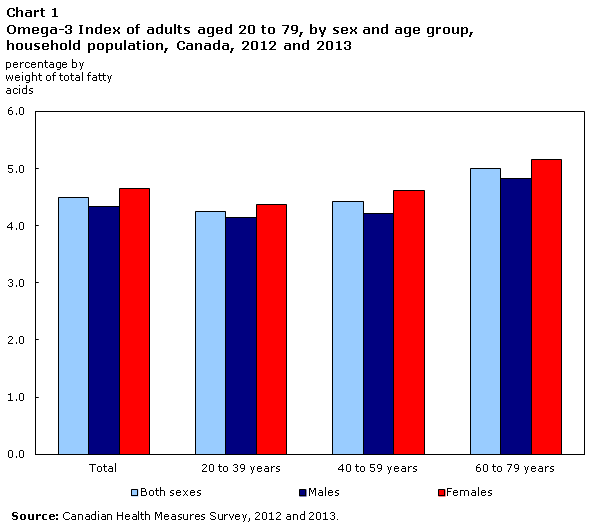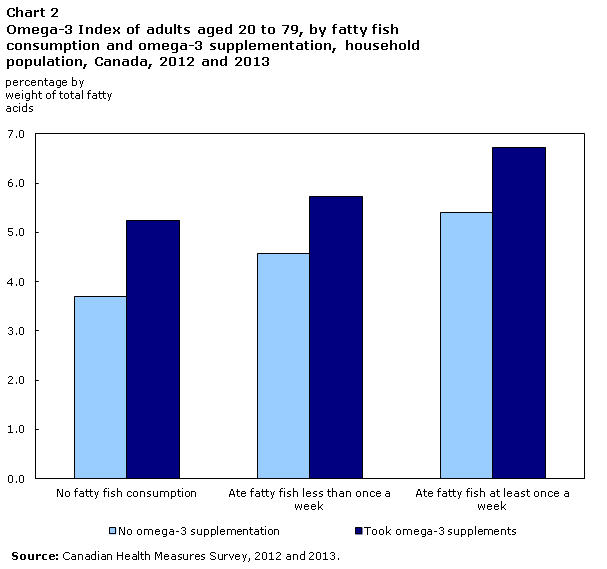Omega-3 fatty acid levels of adults, 2012 and 2013
Archived Content
Information identified as archived is provided for reference, research or recordkeeping purposes. It is not subject to the Government of Canada Web Standards and has not been altered or updated since it was archived. Please "contact us" to request a format other than those available.

There are three major omega-3 fatty acids, also known as n-3 polyunsaturated fatty acids (n-3 PUFAs). These are eicosapentaenoic acid (EPA), docosahexaenoic acid (DHA) and alpha-linolenic acid (ALA). The most widely available dietary source of EPA and DHA is fatty fish which includes salmon, herring, mackerel and sardines. ALA, on the other hand, is found in plant-based foods such as green leafy vegetables, nuts, flaxseeds and vegetable oils. When consumed, the body converts ALA to EPA and DHA. Increased consumption of omega-3-containing foods, fish in particular, has been shown to reduce the risk of cardiovascular disease.Note 1
The Omega-3 Index is the sum of EPA and DHA in red blood cell fatty acids. This index is considered to be a good indicator of the potential risk for coronary heart disease mortality since the blood concentration of these two omega-3 fatty acids is a strong reflection of dietary intake.Note 2 Omega-3 Index risk zones are (in percentages by weight of total red blood cell fatty acids):
- high risk (of coronary heart disease); less than 4% of total red blood cell fatty acids;
- intermediate risk; 4% to 8%;
- low risk; greater than 8%.Note 3, Note 4, Note 5
The Canadian Health Measures Survey (CHMS) measured red blood cell fatty acid levels, including omega-3 fatty acids and the Omega-3 Index. The levels are reported as a percentage by weight of total fatty acids.
Omega-3 Index by sex and age group
Results on Omega-3 Index levels (data not shown) from the 2012 and 2013 CHMS indicate that 2.6% of the population were considered at low risk for coronary heart disease, while 54.6% were at intermediate risk and 42.7% were at high risk. The average Omega-3 Index for Canadian adults was 4.5% (Chart 1). The average Omega-3 Index for males was 4.3%, which was significantly lower than females at 4.7% (Chart 1). The oldest age group, 60-to-79-year olds, had a significantly higher Omega-3 Index (5.0%), compared with 20-to-39-year olds (4.3%) and 40-to-59-year olds (4.4%) (Chart 1).

Omega-3 Index by fish consumption and omega-3 supplementation
Among 20-to-79 year old Canadians, 54.7% reported consuming fatty fishNote 6 within the last month (data not shown). These Canadians had a significantly higher Omega-3 Index at 5.0%, compared with those who reported that they had not consumed any fatty fish, 3.8% (data not shown).
Significant differences were found between the Omega-3 Index of people who took omega-3 supplements and those who did not, regardless of how often they ate fatty fish (Chart 2). Canadians who consumed fatty fish more than once a week and took omega-3 supplements had the highest Omega-3 Index, 6.7% (Chart 2).

About the omega-3 fatty acids
Omega-3 fatty acids are an integral part of cell membranes throughout the body. The way in which high levels of omega-3 fatty acids protect against cardiovascular disease is not clear, but it has been suggested that they help reduce the formation of plaque within the arteries, reduce inflammation and cause a mild hypotensive response (lower blood pressure).Note 3
The omega-3 fatty acids were measured in red blood cells and the means are expressed as a percentage by weight of total fatty acids. Respondents were asked about their fish consumption, including type of fish and the frequency of consumption. Medication and supplement use was also collected.
Data
Additional Canadian Health Measures Survey information is available at www.statcan.gc.ca/chms.
For more information on the Canadian Health Measures Survey, please contact Statistics Canada's Statistical Information Service (toll-free 1-800-263-1136; 514-283-8300; infostats@statcan.gc.ca).
Notes
- Date modified:
